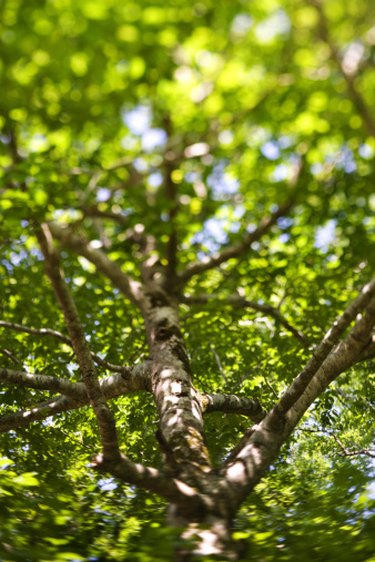Things You'll Need
Ladder
Tool sharpener
Bypass hand pruner
Lopper
Saw
Fertilizer
Water

When a tree has a lopsided area and you want to increase the growth of the slower growing side, there are several things you can do. Pruning is one of the best ways to encourage a tree branch to grow. Pruning and thinning upper-story plants to allow more light into a poorly performing understory tree or bush can help stimulate growth in a branch. Thinning or heading cuts are also useful for encouraging growth, but which one to use depends on the location of the branch.
Step 1
Sharpen all your cutting implements so you make good clean healthy cuts. Hold the blades at a slight angle and drag across the sharpener.
Video of the Day
Step 2
Set up a ladder on a flat area near the tree. It is best to have someone with you when you are on a ladder for safety's sake.
Step 3
Remove the distal or upper stems on the branch stems to promote hormonal growth. The removal of the smaller upper stems forces a hormonal surge that causes the tree to produce more cells in that branch. This must be done as soon as the first buds appear on the tree.
Step 4
Cut off any water spouts or suckers that are taking energy for growth that could be used to promote the formation of a larger branch. These types of growth are spindly and not useful. They also interfere with the normal growth of the tree. Remove suckers to the ground and waterspouts to the next healthy horizontal branch.
Step 5
Make heading cuts on young trees to promote branch growth. Use heading cuts on wood that is one year old but no older or you will stimulate waterspout formation. Cut back the lateral branch or main upper vertical stem to a healthy growing point. Make the cut 1/4 inch above a lateral bud.
Step 6
Thin out the canopy of the tree. Remove secondary wood that is spindly and not well formed. Prune stems back to the next wood but don't cut into the wood. Leave a 1/4-inch edge to protect the healthy wood.
Step 7
Promote a healthy tree for best branch formation and growth. Fertilize at the appropriate time for the species, and provide adequate water. Watch for insects or disease, and deal with them as soon as possible. A healthy plant is more likely to have good branch growth.
Video of the Day